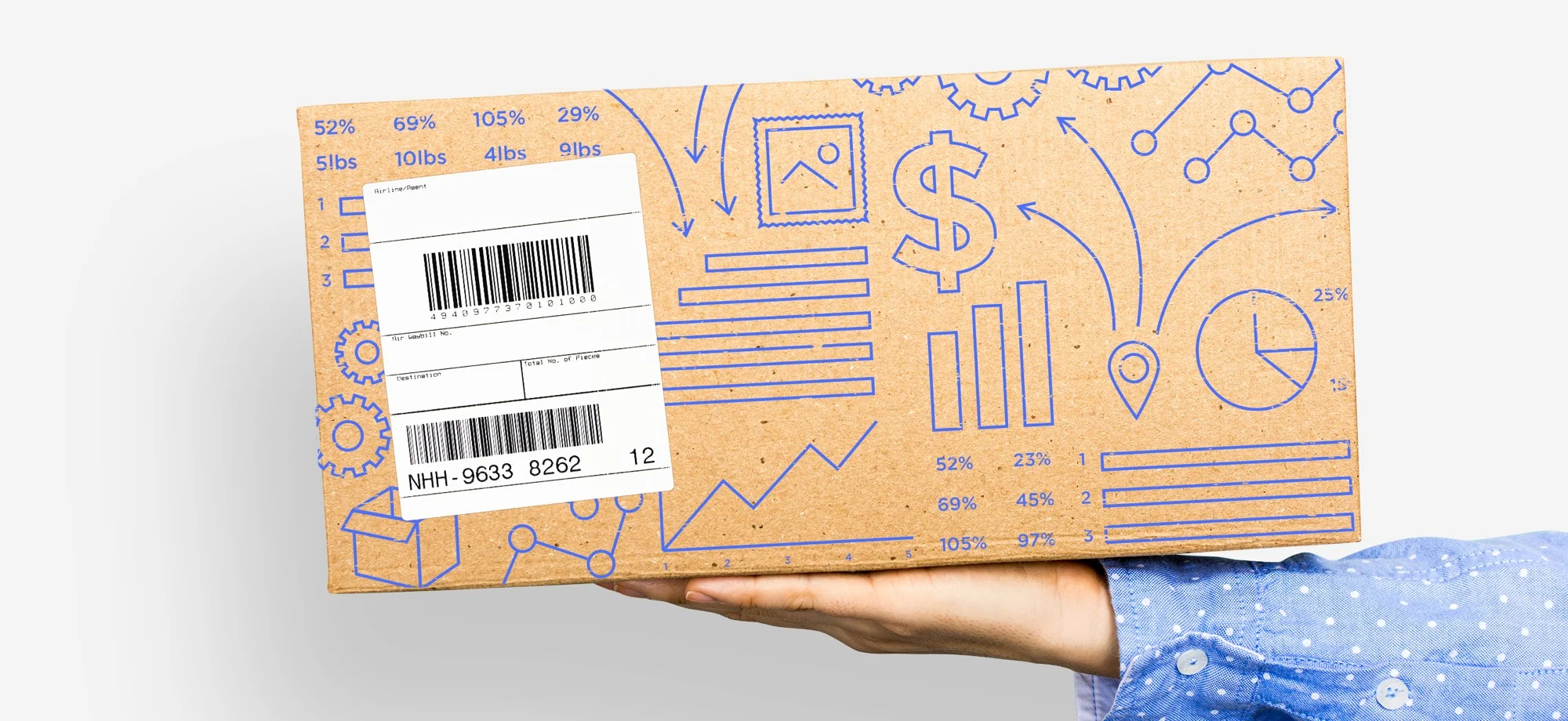Shipping Rates 101: How to Calculate Shipping Costs

In the next chapter of our small business guide to shipping, we’ll look at turning you into a real-time human calculator for shipping costs.
Much like there is a difference between retail and wholesale pricing, so too are there differences in how rates are calculated for shipping.
Most of the time these are based on how much you ship with a certain carrier. Or what technology you use. Or what type of packaging you use.
USPS
Rates with the United States Postal Service are perhaps the most cut-and-dry while also being the most complicated. There are three basic tiers of rates with the shipping carrier (in order from most to least expensive): Retail, Commercial Base Pricing (CBP), and Commercial Plus Pricing (CPP).
Retail
The first, as you may guess, is what you’ll receive if you stand in line at the post office.
Retail rates are the highest rates you’ll find at the post office, and what USPS.com will show you as the “compare to” rate if you go through their Click N Ship (TM) program.
These rates saw an increase in early 2016 and these rates are, unofficially, meant for the end consumer to ship cookies to/from Grandma, not the baker who has 200 hungry customers.
Commercial Base Pricing (CBP)
CBP rates are the first tier of the commercial world when it comes to USPS pricing — hence the name. If you are signed up with a shipping software, the USPS postage accounts that many of those software services provide offer CBP rates on your USPS labels.
These kinds of discounts, if you ship through USPS a bit, can sometimes have the cost of the shipping software pay for itself within a few labels.
Commercial Plus Pricing (CPP)
The best rates you can get are the CPP rates. For these, you usually have to qualify by shipping a certain volume of shipments over the course of a given length of time, however, there’s at least one shipping software — like ShipStation — that will give you these rates by signing up with them. These rates can save you up to several dollars per package and with rates always on the rise, getting the deepest discounts on shipping is more important than ever.
Cubic Pricing
Although it’s not a tier in the same way as the previous four are, cubic pricing is still a contender to save you a bunch of money.
Rather than use the weight of the package, the shipment’s rate is based on how big the box size, specifically how much cubic room it takes up. These rates require certain things, like fitting within a certain cubic size as well as being under 20 lbs. However, if you ship small, heavy packages, the rates can be much less when compared to your normal shipping costs.
UPS & FedEx
Much like with USPS, both UPS & FedEx have their own tiers of rates, though they are a bit less clear-cut. Generally you have two tiers: retail rates and negotiated/contract rates.
Retail
Whether you go to the physical location for either of these carriers or purchase your postage online, the rate is going to be the same. While this makes it simple, once you hit a certain volume, it’s worth it to look into negotiated rates.
Contract Rates
While there’s no set structure as to when you can get negotiated, contract, account-based — or any of the other terms carriers use to describe a discount — rates, they are available. The best way to start the ball rolling on these is to contact the carrier directly once you do a fairly large amount of business with them. Some carriers have even been known to simply give out a discount once you hit certain thresholds.
The two main rate structures of both UPS & FedEx do not include any of their special programs that they have available. Depending on if you’re a member of an association, or sign up for one of their savings programs, you can sometimes get discounts off the retail rates without having to necessarily go through and negotiate them specifically for your account.
Dimensional Pricing
And just like there is cubic pricing for USPS, so too is there dimensional pricing for UPS & FedEx.
But with one big difference: it’s not a special program or rate group — dimensional pricing is how your shipments are calculated no matter if you have retail or contract rates with the two carriers.
Just like cubic pricing, the dimensional weight is based on the size of the box rather than its actual, physical weight. The catch is that, when deciding how much to charge you, UPS & FedEx will use the higher of the two rate versions — dimensional weight versus actual weight — whether you’re on contract rates or not.
How do you save money on postage?
Now that you know the difference between all the rates, it’s time to figure out how to get them to work for your business. The below examples can help to give you ideas on ways to save money.
However, you definitely need to take a look at your business, your products, your shipping process, and your needs in relation to your promises to your customers in order to choose the best shipping method.
1. Flat Rates
Both USPS and FedEx offer flat rate services for which there is no initial qualification, and can be cheaper than a similar shipment through either of the carriers’ alternative services. Each of the two carriers offer free packaging in a number of different sizes, though the catch is that using those boxes is only way you can use the flat rate services.
However, this makes standardizing your box sizes and rate calculations easy since there are not very many variations. Specifically for USPS Flat Rates, there are even international versions to help make selling to overseas customers a bit less of a risk when it comes to postage costs.
2. USPS Regional Rate
The term “regional” means, in this instance, that the rate you pay depends on the region (or zone) where you’re sending your package. However, you can use the regional boxes anywhere within the United States.
The best savings occur using Regional Rate Priority Mail for packages traveling short distances. In addition, Regional Rate Boxes work well for small, bulky packages that could otherwise be very expensive to ship, such as shoes and other clothing items. Much like for flat rate service, you may only use the USPS-produced Regional Rate Boxes, and they each have their own specifications.
3. Hybrid Services
Both UPS and FedEx have partnered up with USPS to provide hybrid services to aid in residential deliveries. Depending on the service, SurePost for UPS or SmartPost for FedEx, you can save up to 50% on using the hybrid service over standard rates.
The trick with these is that UPS and FedEx will pick up the package initially, but eventually hand it off to USPS for final delivery to the customer. While it ends up taking longer in delivery times, it can save you quite a bit of money. In addition to the cheaper cost, you also get free Saturday delivery—technically—(since USPS is the one who’s delivering it) as well as no residential surcharge from UPS & FedEx.
4. Consolidators
Even if you don’t do a lot of shipping, it may be worth it for you to look into shipping consolidators. These companies, like Asendia, Globegistics, and even services from larger carriers like UPS Mail Innovations, can offer better rates than what you get by using the “standard” services from carriers.
These options can be a great way to get deeply discounted rates on postage without having to ship a large volume of packages yourself. There are many companies out there with their own strengths, weaknesses, and requirements, so this option may be a bit more time-intensive to attain savings versus the options listed above. However, if you do your due diligence in finding the right consolidator for your business, it can lead to fantastic savings.
5. Pickups
The type of pickup you have currently scheduled with your carrier can influence your rates. In some cases, you have to pay a monthly amount in order to receive a daily pickup, but the rates you get in return can help to alleviate that cost or even save you money over what you were paying before.
Depending on which carrier(s) you’re using, investigate the type or pickup options they offer, how much they cost, and what kind of influence they may or may not have over your postage rates. Don’t forget to include the time you save by not driving to the carrier’s physical location in your cost valuation, as well.
Now that you’ve mastered building an efficient warehouse and shipping rates, it’s time to look at what not to do in the world of online shipping.

Joey Blanco is the content and social media coordinator at ShipStation. He's been a researcher and success manager for online businesses looking to scale their shipping operations for more than 3 years. When he isn't helping online businesses with their shipping needs, he's out in Austin, Texas walking dogs for shelters and writing their biographies to increase adoption rates.


